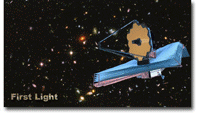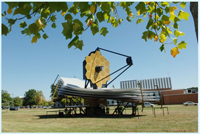Summary
 |
JWST will address a number of key topics in modern astronomy providing astronomers with the tools needed to understand the formation of galaxies, stars, planets, and ultimately life.
The primary science goals guiding the design of JWST can be grouped into four broad themes:
- The early Universe: What did the early Universe look like? When did the first stars and galaxies emerge?
- Galaxies over time: How did the first galaxies evolve over time? What can we learn about dark matter and dark energy?
- The lifecycle of stars: How and where do stars form? What determines how many of them form and their individual masses? How do stars die and how do their deaths impact the surrounding medium?
- Other worlds: Where and how do planetary systems form and evolve?
 |
|
Full-scale model of JWST in the grounds of GSFC. Credit: NASA |
The observations required to address these science themes require a large telescope sensitive to infrared radiation.
JWST consists of a passively cooled 6.5m-aperture telescope that is optimised for diffraction-limited performance in the near-infrared (2-5μm) region. Detection sensitivities extend to either side of this band, stretch into the visible (0.6-2μm) and mid-infrared (5-28μm).
JWST's large aperture and shift to the infrared is driven by the desire to detect the contents of the faint extragalactic Universe back in time and redshift to the epoch of 'First Light', when the very first stars ignited. Nonetheless, like the HST, JWST will be a general-purpose observatory and carry a suite of instruments capable of addressing a broad range of outstanding astronomical problems. In contrast to HST, however, JWST will be placed into a Sun-Earth L2 halo orbit and will not be serviceable after launch.
